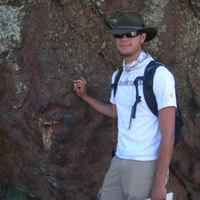 Fault zone architecture of the San Jacinto fault zone in Blackburn Canyon: evidence for fluid flow in the shallow brittle crust during rupture eventsDaniel Pelikan June 12th, 2012 |
||
|
||
| ABSTRACT The San Jacinto fault zone is exposed in Blackburn Canyon in a stream cut channel 15 km SE of Hemet, California. The fault is bounded on the NE by the Thomas Mountain Tonalite, and the Bautista Metamorphic Complex on the SW. The aim of this study is to characterize distinct architectural zones across a perpendicular transect through the more homogenous and better exposed tonalite that makes up the NE side of the fault. Through characterizing each architectural element it is possible to infer the extent of the damage zone, rupture/deformation dynamics, shallow crustal fluid flow, and larger scale alteration trends. Twenty-four samples were analyzed for bulk and grain density, major and trace elements, clay mineralogy, texture and modal mineralogy, and microfracture density. In addition, porosity and volumetric strains were calculated from geochemical and density data. Decreasing bulk and grain density is accompanied by increasing porosity and dilational volumetric strain with proximity to the fault core. Thin section observations indicate decreasing grain size and greater communition towards the fault core. Point-count data also suggest dissolution of plagioclase and increasing amounts of quartz towards the fault core. Microfracture density within quartz grains increases with proximity to the fault core and fits an exponential model. Fracture processes are characterized by mode I cracking. X-ray diffraction analysis of the less than 4 micron fraction separated from samples from each architectural zone indicate a general trend of increasing illite in illite/smectite towards the fault core. Such a relationship implies an increasing energy gradient with proximity toward the fault core. Alteration trends displayed on an A-CN-K ternary diagram agree with this observation as data spread from relatively unaltered samples collected from the outer damage zone toward illite. In short, the results from this study indicate a broad damage zone along the NE side of the San Jacinto fault in Blackburn Canyon (~1 km), and a marked increase in mechanical deformation and geochemical alteration within a narrow zone approximately 5 meters wide surrounding the active fault core. Moreover, the magnitudes of documented changes in elemental mass can only be explained by fluid flow which likely played an integral role in rupture dynamics and the resulting fault zone architecture. |

